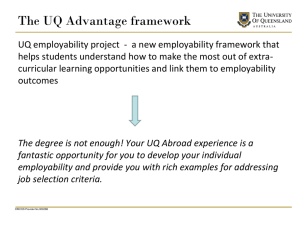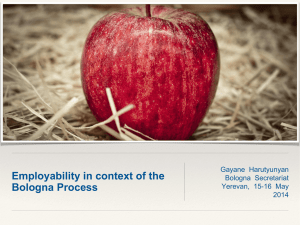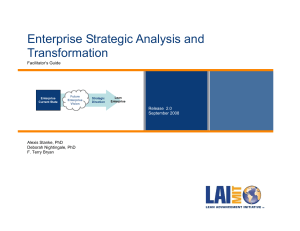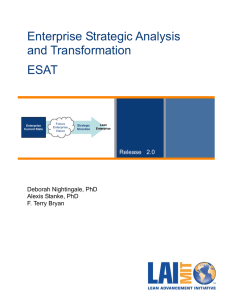Employability Skills Assessment Tool (ESAT)
advertisement
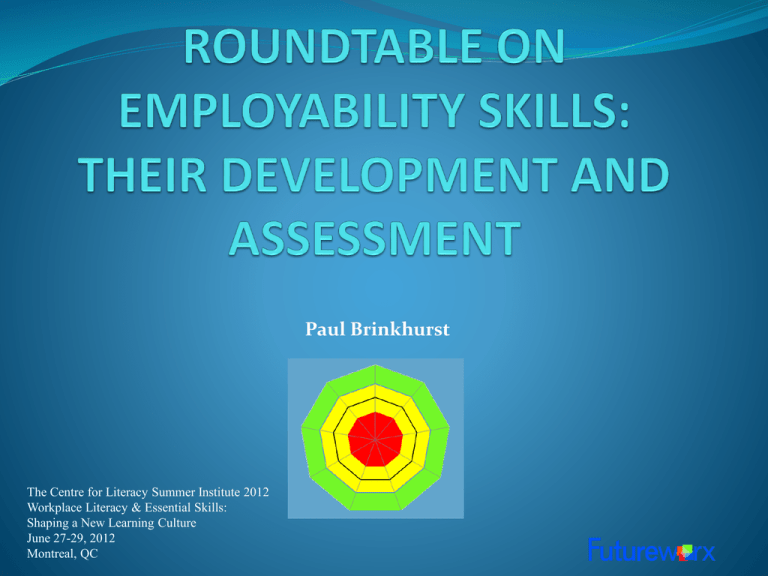
Paul Brinkhurst The Centre for Literacy Summer Institute 2012 Workplace Literacy & Essential Skills: Shaping a New Learning Culture June 27-29, 2012 Montreal, QC Outline The Skills Pyramid Building Employability Skills Assessing Employability Skills Your Input: Possible applications Your needs ( guides, curriculum etc.) Your limitations (cost, staff, time…) Participation: Level 1 – informal feedback Level 2 – formal feedback Conclusion The Skills Pyramid JOB ESSENTIAL EMPLOYABILITY Employability Skills Based on our 25+ years in the field, our list of KEY employability skills is: Attitude Adaptability Motivation Stress Management Presentation Accountability Teamwork Confidence Time Management DEVELOPING EMPLOYABILITY SKILLS…. The Glenwood Method: Integrated Skill Development On the job at all times Contextualized learning Hands on skill development The principles…. Common expectations: 1. - For both staff and learners – on the job at all times Common skill definitions Detailed guidelines Assessment rubrics for each skill RED TIME MANAGEMENT VERBAL TIME MANAGEMENT PHYSICAL TIME MANAGEMENT CONSISTENT TIME MANAGEMENT (time) CONSISTENT TIME MANAGEMENT (place) SCALE YELLOW GREEN - excessive hesitation - excessive speed - excessive talking with others - clarity drops with excitement or shyness - arrives /leaves at the wrong time - makes excuses for lateness - does not meet deadlines -does not set or follow proper priorities - is inattentive to the time -cannot tell time. - cannot read schedules - does not plan ahead - improving ability to meet/use simple schedules effectively - attempts to meet assigned priorities - attempts to be attentive (uses strategies) with some success - shows signs of planning ahead to improve efficiency - is late or misses deadlines only at specific times (morning, after break etc) - is occasionally late or misses deadlines - exhibits appropriate time management skills in some venues - usually or always late regardless of time of day - never pays attention to or forgets deadlines - does not demonstrate appropriate time management in any venue 1 2 3 4 5 - can communicate an idea verbally both effectively and efficiently - appropriate hesitation - talking for work purposes - clear speech - arrives and leaves on time -meets deadlines -is attentive and efficient - can plan ahead and use foresight - sets/meets own priorities effectively -can use complex schedules -can make schedules - is rarely or never late - consistently meets deadlines well throughout their workday - exhibits appropriate time management skills in most/all venues 6 7 8 Developing Employability Skills 1. Create common expectations 2. Involve all staff in observing client strengths and weaknesses in a variety of venues and situations - always be watchful for opportunities to praise and obligations to adjust behaviours - common observation recording and management system Observation Record Developing Employability Skills Create common expectations 2. Involve all staff 1. 3. Provide honest, consistent, timely and respectful feedback - honest: do not mask the truth. Tell it like it is. - consistent: all staff respond the same way. - timely: respond when the behaviour occurs. - respectful: establish a relationship of trust. Developing Employability Skills Create common expectations 2. Involve all staff 3. Honest, consistent, timely and respectful 4. Involve clients in finding and evaluating new behavioural strategies - one-on-one counsellor/client partnership - opportunities for testing in the work place 1. Developing Employability Skills 1. 2. 3. 4. 5. Common expectations Involve all staff Honest, consistent, timely and respectful feedback Involve clients in new strategies Use a consistent assessment process to track change - Employability Skills Assessment Tool (ESAT) Assessing Employability Skills How do you assess attitude, confidence, etc? How do you show employability skill program effectiveness? How do you motivate clients or funders when improvements are hard to demonstrate? Embracing the subjectivity… ESAT INVOLVES: 1. 2. 3. 4. 5. 6. Repeated client self assessment surveys Repeated staff assessments by rubric Staff Consensus Perception comparison and analysis Client debrief and strategizing Distance Travelled Assessment Self Assessment 58 to 100 descriptive statements Clients assign scores 1 to 8 re applicability Clients score with respect to work, and with respect to home ESAT generates a score for each skill (8 being optimal) Staff Assessment Each staff member assesses a client using the definitions and rubrics on a 1-8 scale Assessments are : Independent Based on observations over previous 4-6 weeks Staff Consensus Weekly client reviews Individual staff scores are presented and discussed Staff reach consensus: Create a deeper shared understanding of the client Help reveal any bias that may exist Ensure staff can substantiate scores Comparison Output Debrief learner… Identify strengths Identify opportunities for growth Discuss differences in perspective Brainstorm new behavioural strategies Reach agreement ( verbal, formal or contract) Distance Travelled Key Points Requires consistent application of common skill definitions and expectations Requires strong communication between staff Requires an investment of time in the client But…. IT WORKS! WAY AHEAD Funding from Counselling Foundation of Canada Includes software to run on an intranet or workstation Includes user guide Available January 2013 First 100 copies will be provided to non-profits at no cost – just a promise to provide feedback Questions? YOUR INPUT Possible Applications: addition to employment training programs YOUR INPUT What would you need to implement such a system: Guide – ESAT or full method? Training? Curriculum supports? Ability to adjust the tool? Skills? Questions? Rubrics? Your Input #3 What limitations or problems do you foresee? Time? Staff commitment? Training? Cost? Ability to do work simulation? Participation Level 1 – Use the ESAT and provide informal feedback on the tool and its effectiveness Level 2 – Use the ESAT for a year and provide formal feedback on its utility, effectiveness including feedback from participants. ESAT PARTICIPATION: Name of Organization: _______________________ Contact Name: ______________________________ Email:_________________Phone: (___)__________ Interested in: Level 1 2 Other… (please specify): Comments:



